Cruise day: 122/152
Ports days: 58
Sea days: 64
Countries: 20
Continents: 5
Ports: 42 |
| I thought I heard something when taking this selfie - not sure what it was... |
December 24, 2021. That's when we sailed from Ft. Lauderdale. Today is April 24, 2022. We've been on this ship now for four months. Amazing.
Today, we docked in Naples, Italy just before noon.
That allowed us to have almost a sea day morning that included bridge lessons - today, Jacoby transfers. Do I sound like a bridge player yet?
When we arrived back at our room, I looked outside and noticed we had picked up a hitchhiker.
A moth was going for a little ride. Hope it got to where it was headed.
Viking offered up a brunch today on the pool deck. While great, it didn't offer anything that we felt was compelling so we opted to eat in the World Cafe for breakfast and lunch before our 1:15PM excursion to Pompeii.
 |
| Caught this interesting looking building as we left the port |
 |
| Our first view of Mount Vesuvius |
Pompeii was a thriving Roman city near Naples. With its own port, Pompeii was a bustling business center with active shops and businesses, including the oldest profession. In 62 A.D., the city was devastated by a major earthquake. That didn't deter the entrepreneurs in Pompeii who rebuilt the city, improving on it in the process. All was well for 17 more years, until October 24, 79 A.D. when nearby Mount Vesuvius erupted, blanketing the entire city under meters of pumice and ash. In addition to burying the city, as the erupted material hit the sea, it released noxious fumes, ensuring that the entire population was wiped out in a matter of a few days. They believe that the eruption happened on day #1, followed by ash and gasses on day #2. Day #3 brought lava and the complete burial and elimination of the entire city of Pompeii. It sat underground for years until being discovered in the late 16th century. Excavations have been happening since. Because of the way it was buried, much of Pompeii is amazingly well-preserved. Our guide said that 20,000 people lived in Pompeii, but Wikipedia suggests that the number is closer to 11,500, based on the number of residences that have been discovered. Let's call it between 10,000 and 20,000, depending on what research you believe.
The initial thought was that the eruption happened in August, 79 A.D. As they found remains, the fruits and vegetables that were found preserved in the ash and lava were ripe later in the year than August, pushing the date to October.
 |
| We entered Pompeii |
 |
| This was a gymnasium area where athletic events, including gladiator fighting,, happened |
 |
| You can see the larger theater in the background - more from there below |
 |
| Combatants many times were slaves who were held in these jail-like cells inside the gymnasium walls |
 |
| After the earthquake of 62 A.D., some of the buildings were reconstructed using mixed materials like terra cotta bricks mixed with volcanic stone |
 |
| The small theater seated about 1,500 |
 |
| The large theater seated a little under 4,000 |
 |
| Note Arlona up on the top right corner |
 |
| Arlona's view from the top |
 |
| This is one of the many secondary streets - the streets were lined with businesses like bakeries |
 |
| These stones were placed very deliberately - first, they gave pedestrians a way to cross when heavy rains were causing the street to flood - second, the spacing allowed chariot wheels to pass between |
 |
| Arlona spotted this lizard hanging out on one of the rocks - Google Lens suggests that it is an Italian wall lizard |
 |
| Check out that green and blue coloring |
 |
| Our guide explained that these thermal pots in the businesses were used for cooking items for sale |

 |
| Chariot ruts in the road |
The following writing is names of politicians that were written on the walls by their supporters, back in the first century.
Our next stop was the House of Menander - a residence that has been partially excavated. Our guide said that this was a three-story dwelling with a partial floor above us and another below.
The quality of the art on the walls was amazing.
 |
| A sunken tub |
 |
| A cistern near the sunken tub |
 |
| The central garden in the home |
 |
| The mosaic floor in the bath |
 |
| Perhaps that was the family dog on the left |
 |
| Bones of some who perished - most likely slaves |
These homes had running water - an amazing thing. It was all due to the aqueduct that supplied water to Pompeii. The water was piped to the homes of those that could afford to pay the taxes that came with in-home water delivery. For those that couldn't afford it, public fountains were placed throughout the city.
 |
| A bakery - note the oven on the left and the milling stone near the middle |
 |
| I'll bet this would crank out a killer wood-fired pizza |
 |
| Another secondary road |
 |
| Here we are on the Via dell'Abbondanza - the main roadway in Pompeii |
 |
| The Via dell'Abbondanza was nearly twice as wide as the secondary roads and featured businesses along both sides |
 |
| Another public fountain |
We entered an area that featured one of a few plaster casts than have been made here in Pompeii. As excavations happened, occasionally, they would encounter a void. They started filling these voids with plaster and made castings. What they found was many of these voids are where people or animals were trapped in the lava. After their bodies decayed, it left a void. By filling it with plaster, they can create a casting that more or less shows what was in that void at the time of the eruption. This one was obviously a person, most likely a man.
In addition to running water, Pompeii had other creature comforts. This was the sauna. They had a fully heated sauna as well as warm and cool rooms and massage rooms.
 |
| Original lead piping that carried water for the sauna |
 |
| A painting featuring a snake - most likely identifying a pharmacy |
 |
| This is an old, really old, in fact, the oldest business - a brothel |
 |
| We're hoping that they had pads for the beds |
You selected your "services" from a handy menu painted above the doorways. Hmm...one of those, one of those - ohhh - two of those, please!
 |
| More of the original lead piping in the city |
 |
| Some of the secondary roadways were quite narrow |
 |
| In today's world, a phallus is considered impolite or offensive - back in Pompeii's heyday, a phallus was believed to bring good luck and draw the gaze of evil, keeping it away from the good people - this one was on the side of a building |
 |
| This was carved in a stone on a roadway |
 |
| A little size reference - she's a women's 10 for the record |
 |
| Another public fountain |

 |
| Our guide demonstrates how folks would simply bend over and grab a drink from the mouth |
 |
| Note the terra cotta pipe on the right |
 |
| They had in-wall piping, perhaps part of a chimney |
 |
| More mosaic flooring |
 |
| Blocks like this appeared at the end of a pedestrian roadway, blocking access for chariots |
We finally arrived at the forum - the town meeting place. It was lined with businesses and featured a central meeting place for the city.
 |
| Mount Vesuvius is roughly 10km or about 6 miles from Pompeii |
 |
| The following statue was built for Pompeii in 1994 |
 |
| As we started leaving, going past the Marina Gate, our guide pointed out the marble pieces embedded into the roadway to reflect the light and sparkle |
 |
| Below was the pedestrian entry from the Marina Gate - the city was an important port but that has silted over and Pompeii now sits some distance from the water |
This is another recent statue. Note the openings in the body where another face can be seen.
We had a little free time to browse the local shops that sell jewelry made from "Mount Vesuvius lava stone." But, if you look, it is all fake and made in China. It's right on the label or stamped on the products. It's a shame as it gives all local vendors a bad name.
As we headed back to port, we could see the Sorrento peninsula on the left and the island of Capri on the right.
All aboard time was 7PM and we sailed shortly after.
Tomorrow, we will dock in Rome's port of Civitavecchia. We have a 10.5-hour excursion tomorrow that will take us to many of the highlights in Rome as well as the Colosseum.
One more tidbit - remember the insane security and COVID restrictions in Venice? I'm happy to report that the same isn't true in Naples. We can explore on our own. There was no crazy port security. We are being told that we need to wear KN95 masks, not regular cloth ones and that only applies to transport and indoor settings. But, I see others, including tour guides, wearing regular old masks, so I don't understand that one. We are also required to carry a European locator barcode, but nobody asks for it. We'll see what happens tomorrow in Rome.








































































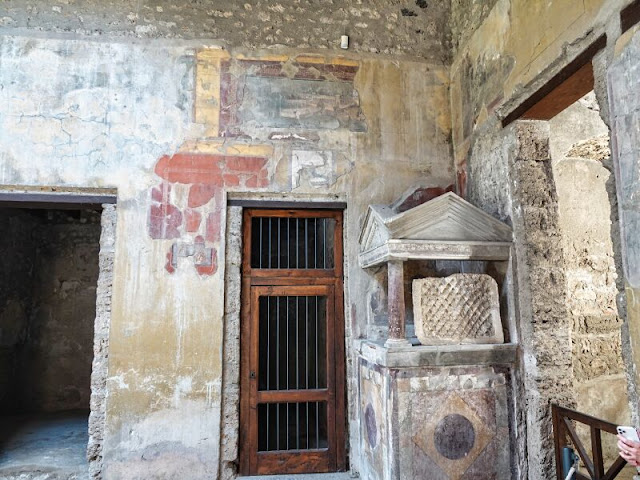










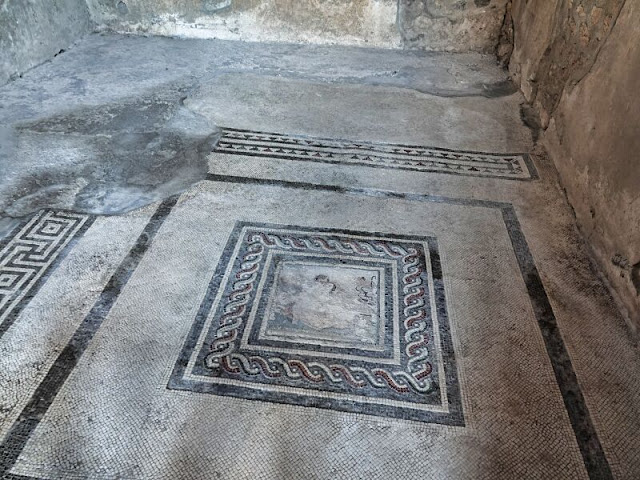


















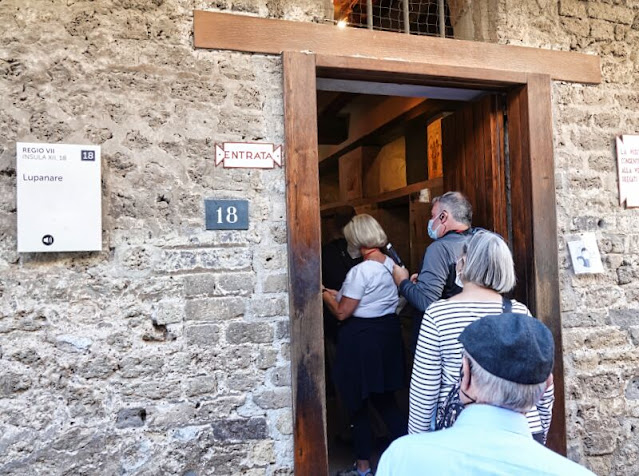




















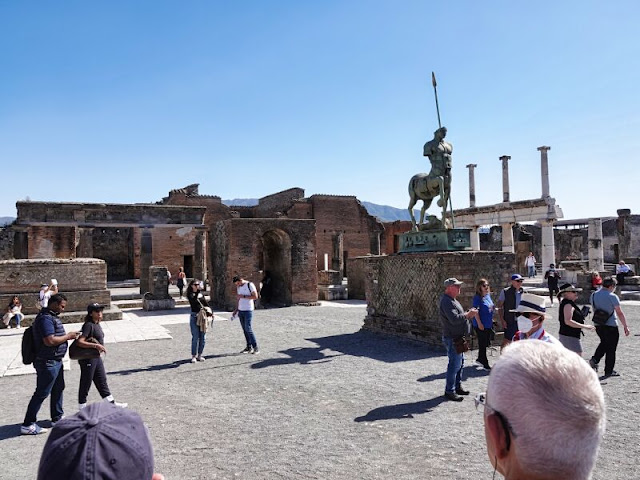

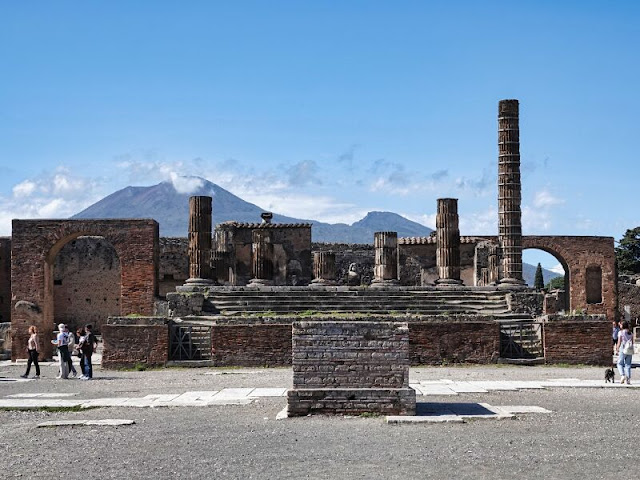
































Wonderful description of this excursion. Viking has this excursion listed as "Strenous". Would you agree with that assessment?
ReplyDeleteIt is actually called "demanding", and absolutely. Lots of walking, including a lot of uphill, uneven surfaces and a few stairs.
Delete